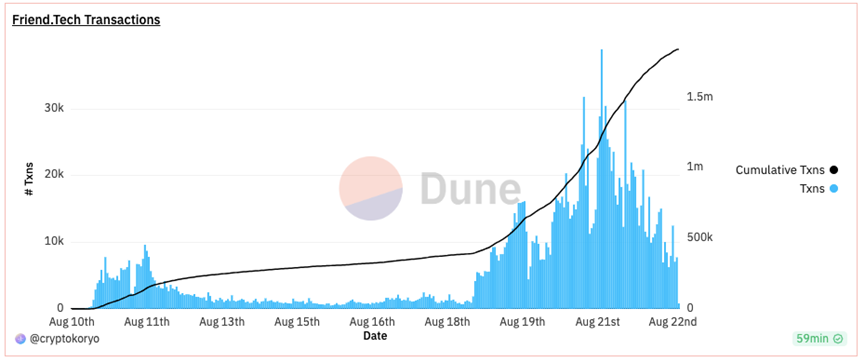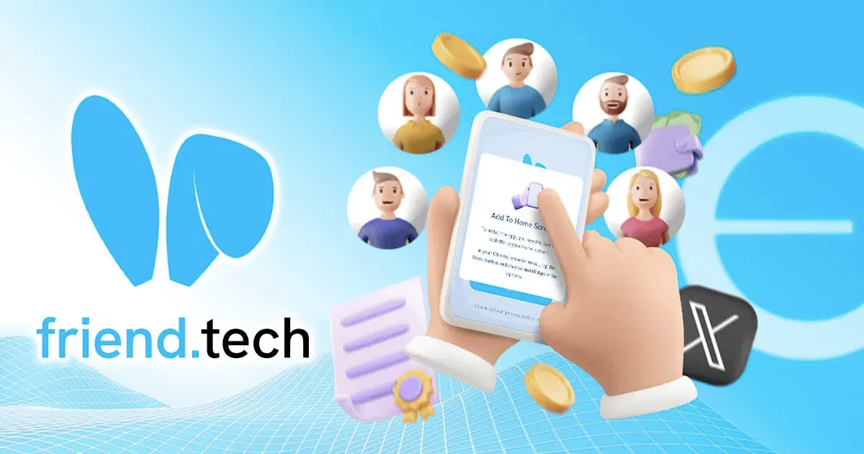
Author: Daniel Li, CoinVoice
As one of the highly anticipated projects on the current Base chain, Friend.tech has shown tremendous potential. In less than two weeks, its trading volume has exceeded 25,633 ETH, attracting well-known individuals and venture capital companies to join in succession. These additions have injected more exposure, social influence, and trust support into Friend.tech, making it the current highly anticipated Web3 social favorite. However, behind the popularity of Friend.tech, people are more concerned about its future direction. Past SocialFi applications such as BitClout have proven that early product popularity does not necessarily mean a promising future.
Although Friend.tech is excellent, it is still in the early stages of development and has not yet matured. Therefore, we need to analyze the innovative features, competitive advantages, and current shortcomings of Friend.tech in depth to help us more accurately assess its future development potential.
What is Friend.tech and Why is it Popular?
Friend.tech is a DApp based on the Base ecosystem, which allows users to buy and sell shares of users on Friend.tech using Ethereum on the Base chain in a way strongly tied to Twitter. Its main function is similar to WeChat groups and Telegram groups, but its core lies in the organic entry and exit of group chats. Users can choose to join a group chat and pay the base price to acquire shares of that group. If they want to exit the group chat, they can sell the shares they hold.
Joining a group chat not only meets social needs but also has investment potential. As the number of people joining a group chat gradually increases, the total shares of the group increase, and the base price of each share also increases. This means that joining a group chat not only satisfies social needs but also allows for investment returns. Therefore, speculative users often buy shares of other group chats they believe have potential or their own group chat in the early stages.
According to data from Dune Analytics, since the launch of the test version of Friend.tech, it has attracted 7,860 users and a trading volume of 4,400 Ethereum (equivalent to $8.1 million) in less than 24 hours, with over 126,000 transactions. This far exceeds the trading volume of OpenSea during the same period. As of now, Friend.tech has attracted the attention of over 100,000 users, and well-known KOLs such as Frank DeGods and Gainzy222, trader RookieXBT, and NBA player Grayson Allen have also joined this trend.

The reason why Friend.tech is so popular is that both market opportunities and marketing strategies are indispensable. After the GameFi craze, the entire industry is looking for the next application that can break traditional boundaries. SocialFi, as a field that combines traffic and encryption attributes, is seen as one of the most hopeful directions for breakthroughs. For a long time, people have been trying to use blockchain to create decentralized versions of Facebook (Meta) or Twitter (X), allowing users to own their data and create an on-chain reputation system for social use cases. Friend.tech has emerged to cater to this market opportunity and demand.
Furthermore, as a decentralized social application product, Friend.tech has also been highly effective in project marketing. Friend.tech's marketing strategy combines the strengths of many, focusing on short-term, high-frequency, and intensive public relations strategies, which are classic in terms of content, timing, and community strategies. Early on, they focused on creating a sense of mystery, which sparked users' curiosity. Then, they relied on shoutouts from well-known KOLs to kick-start the product, using these influential figures to promote the product and attract more users. At the same time, they cleverly used invitation codes for viral marketing, stimulating users' desire to participate and guiding more people to join. In addition, with the endorsement of top VCs. It is the skillful use of all these strategies that has created the current popularity of Friend.tech.
Friend.tech: Product Features and Gameplay
Friend.tech is an innovative Web3 application that leads the revolution in the social field. It not only has advantages in marketing and promotion, but also showcases its unique charm through carefully crafted product features. When implementing the KOL monetization plan, Friend.tech drew valuable lessons from BitClout's experience. Compared to BitClout, which faced community resistance due to its forced launch and was eventually integrated into the Deso project, Friend.tech has innovated from the standpoint of protecting user rights and optimizing user experience. It has actively invited KOLs to join and greatly improved user experience through Base chain L2 technology.
Friend.tech also demonstrates innovative charm in its product features and gameplay. The four innovative features it has launched include "social tokenization," "share trading," "fan economy," etc., bringing users a brand-new social interaction experience. These features are all based on decentralization, quantifying and releasing social value through algorithms and market-based means, creating new opportunities for users.

Social Tokenization: Friend.tech quantifies users' popularity and interaction on Twitter into social tokens by associating with their Twitter accounts. This social tokenization mechanism makes users' influence a measurable and tradable asset, providing users with a direct way to participate in and benefit from their influence. Through social tokenization, users can turn their influence into tradable assets with actual value, further expanding the reach of their social influence.
Share Trading: Friend.tech allows users to use ETH to purchase shares of other users' social tokens, which represent the popularity and interaction rights of users on Twitter. Users can freely decide when to buy or sell shares based on market supply and demand and profit from it. This share trading mechanism provides users with a way to invest in and trade social influence, allowing them to participate in the economic system of the social network and share the growth value of their social influence.
Fan Economy and Influence Game: Friend.tech has created a unique influence game with the fan economy at its core. Users can use ETH to purchase shares of other users, gaining the right to have a one-on-one conversation with the purchased user, i.e., a friend slot. Buyers can engage in one-on-one chats with the purchased user, supporting and participating in their favorite social influencers. This design stimulates active user participation in social network interaction and development, transforming social influence into actual social interaction and enhancing connections and activity among users.
Transaction Fees and Revenue Sharing: Friend.tech charges additional transaction fees during the transaction process, with a portion going to the protocol and the rest going to the shareholders involved in the transaction. For the social influencers (KOLs) whose shares are being purchased, each transaction of their shares can earn them a certain percentage of transaction fees. This design encourages KOLs to increase transaction frequency to earn higher revenue and promotes the overall activity and liquidity of the social network.
The Future of Friend.tech Under the Glare of the Spotlight
With its innovative social + economic model, Friend.tech has brought users a new experience of interaction and value realization, igniting a revolutionary wave in the Web3 social field. It has opened up a vibrant and opportunistic new social world for users, whether they are KOLs or ordinary users, to gain richer social experiences and economic benefits through the platform.
However, beneath the surface prosperity of Friend.tech, we see that it still faces significant challenges on its development path. Returning to the product itself, Friend.tech still has many unresolved issues: its sustainability is in doubt, its business model needs to be tested, and it lacks attractiveness to top KOLs, among other issues. These issues will affect whether Friend.tech can go further in the short term under the glare of the spotlight.

First, many people are skeptical about the sustainability of Friend.tech. They question issues such as the lack of a clear privacy policy, the need to deposit Ethereum when registering, and the unclear project roadmap. Due to these factors, people have doubts about the security and long-term development of Friend.tech. In particular, the lack of a clear privacy policy has raised concerns about personal information security, causing users to hesitate when providing personal information to Friend.tech.
Secondly, Friend.tech's business model needs further validation. The application relies on economic interactions between KOLs and fans for monetization, where fans can gain the right to converse with KOLs after purchasing their shares. However, the issue lies in the fact that owning shares does not guarantee a response from KOLs; it entirely depends on the personal willingness of the KOLs. In this model, KOLs are not obligated to respond to fans. Therefore, Friend.tech faces the dilemma of "paying to send messages does not necessarily guarantee a response," similar to sending direct messages on Twitter but not being obligated to receive a response. This makes Friend.tech's functionality more like a display, where fans can only realize benefits by continuously purchasing new shares and waiting for others to take over, casting doubt on the sustainability of the entire monetization model.
Additionally, there is also significant doubt about whether Friend.tech can attract enough KOLs to join. Many KOLs are currently sharing Friend.tech invitation codes on Twitter, but for top industry KOLs, they do not lack monetization channels themselves. More concerning for them is the potential backlash from fans due to the drastic fluctuations in token value after joining Friend.tech, which could affect their influence on other platforms (such as Twitter). For medium and small-sized KOLs, their influence is limited, and even if they join Friend.tech, it is difficult for them to earn substantial income through the platform.
In addition to the above-mentioned issues, Friend.tech also has a potential hidden danger:
Lack of Competitive Product Features: Friend.tech suffers from serious interface malfunctions and lack of features, directly impacting user experience. For example, chat content loading issues and the absence of common features (such as photo sharing) limit users from having a complete social experience on Friend.tech. Despite expanding community features and providing KOL-exclusive VIP content, traditional platforms such as Telegram, WeChat, and Discord groups are already able to meet these needs and have more mature and comprehensive features, making them more sticky for users. Compared to these platforms, Friend.tech does not have a clear advantage.
Lack of Transparency and Planning: Friend.tech has been online for nearly two weeks, but the project has not yet released a whitepaper or roadmap. This has created an impression of vagueness and lack of transparency, weakening people's confidence in the future development of Friend.tech. Users and investors hope to have a clear understanding of Friend.tech's vision, plans, and development direction, and the lack of this information raises doubts and uncertainty.
Compliance Risks: With the rapid development of Web3, regulatory agencies are paying increasing attention to cryptocurrencies and blockchain technology. Friend.tech's business model is somewhat similar to the stock market, where crypto influencers can share profits with buyers to increase trading volume and prices. This could potentially expose Friend.tech to compliance risks of being considered unregistered securities by the U.S. Securities and Exchange Commission in the future.
In summary, as a Web3 social application, Friend.tech's pricing model for personal influence tokens exhibits a trend of FOMO (fear of missing out). Through good airdrop expectations and KOL marketing, Friend.tech may be able to maintain a certain level of popularity in the short term. However, in the long run, this emotionally driven trend is not sustainable. Once the hype cools down, users will return to focusing on the product itself and begin to notice Friend.tech's own shortcomings. If Friend.tech cannot successfully establish a real connection between fans and KOLs, and optimize its product structure and business model, its future growth potential will be greatly limited. In the future, Friend.tech may follow in the footsteps of BitClout and fail to achieve sustainable development.
免责声明:本文章仅代表作者个人观点,不代表本平台的立场和观点。本文章仅供信息分享,不构成对任何人的任何投资建议。用户与作者之间的任何争议,与本平台无关。如网页中刊载的文章或图片涉及侵权,请提供相关的权利证明和身份证明发送邮件到support@aicoin.com,本平台相关工作人员将会进行核查。




